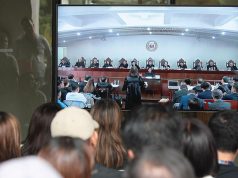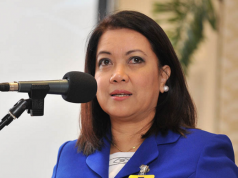MANILA – (UPDATE 11:52 A.M.) Supreme Court Associate Justice Teresita Leonardo-de Castro on Wednesday testified before the House Committee on Justice hearing the impeachment complaint against Chief Justice Maria Lourdes Sereno, confirming the serious protest she had lodged against Sereno’s alleged misrepresentation of the en banc’s Nov. 27, 2012 deliberations on the creation of the Regional Court Administrator’s Office in Region 7.
Sereno’s alleged “fabrication” of a resolution that misrepresented the intent of the en banc on the RCAO 7 – merely to study the need for, not yet create the office – was one of the grounds for impeachment listed in the complaint by lawyer Larry Gadon.
Sereno’s Administrative Order 175-2012 revives the Regional Court Administration Office-7 (RCAO-7) in Cebu City. The order was meant to decentralize the Manila-based Office of the Court Administrator under Midas Marquez but was implemented without the required approval of the en banc.
Fielding questions mainly from Majority Leader Rodolfo Fariñas, Justice De Castro said that after she wrote Sereno to protest the issuance of a resolution that reflected the supposed “ratification” by the en banc, in its Nov. 27, 2012 deliberations, of the revival of the RCAO 7, the en banc met anew on the matter and issued a new resolution. Prodded by Fariñas, Justice De Castro said the en banc resolution “effectively overturned” the resolution issued by Sereno.
“The exchanges among the justice was clear, to just create a study group and the Chief Justice even said I will amend my Administrative Order, and I was relying on that,” De Castro said.
De Castro said she had also taken issue with Sereno’s move to designate Judge Geraldine Faith Econg – someone outside the Office of Court Administrator and accountable only to the Chief Justice – to head the RCAO 7.
Asked if Sereno replied to her letter protesting the apparent misrepresentation, De Castro replied, “Hindi po [No, sir]. She did not reply at all.” Even during the deliberations (the matter was again taken up on Dec. 7), she did not explain [why she issued ] AO 175, Sereno did not address the issue.
In the Dec. 11, 2012 deliberations, the en banc subsequently decided to form a study committee to revisit the need to revive the RCAO and decentralize the functions of the Office of the Court Administrator, and designated Associate Justice Jose Perez to head the study group.
“It is a subtle way of overturning” the Sereno’s issuance of her resolution, said De Castro, noting that “we didn’t want to embarrass” the Chief Justice.
“I’m not after putting her down, I just want to correct what has been done to put things in order as decided by the court in previous resolutions,” De Castro added.
SERENO CAMP INSISTS: NO FALSIFICATION
Reacting to the proceedings at the House Justice committee Thursday morning, the lawyers for Sereno, who have been sending running commentaries to the media, asserted that the “SC en banc approved the creation of Regional Court Administrative Office (RCAO) in Region 7.’
Sereno’s counsel said: “It is false to say that the Chief Justice acted unilaterally and without the knowledge of the Court En Banc when she issued A.O. No. 175-2012. Precisely, the creation of said office, its budget as well as the designation of its staff, had already been approved and delineated in earlier Resolutions of the Court. The Chief Justice, after studying the problems besetting far-flung courts, simply implemented these earlier Court En Banc resolutions creating an RCAO in the seventh judicial region. Contrary to Complainant’s baseless allegations, there is no En Banc Resolution nullifying, superseding or otherwise “scrapping” the Supreme Court’s resolutions creating the RCAO-7, including the assailed 27 November 2012 Resolution in A.M. No.12-11-9-SC.”
VIOLATION OF CONSTITUTION? DE CASTRO MUM
Asked anew by Farinas if Sereno’s issuance of Administrative Order 175-2012 was a violation of the Constitution and the law, De Castro refused to answer.
Farinas added, reading De Castro’s letter, that the said administrative order “has transgressed the said constitutional authority of the court en banc and the statutory authority of the Office nof the Court Administrator.”
Farinas also noted that P.D. No. 828 (Creating the Office of the Court Administrator in the Supreme Court) stated that the Chief Justice can only appoint staff with the approval of the court en banc.
Court Administrator Midas Marquez, meanwhile, gave the lawmakers a background of why the RCAO concept came to be, during the term of Chief Justice Art Panganiban in 2006. It was a move to decentralize the OCA functions to boost its fiscal responsbility, accountability and efficiency.
WATCH NEWS5’S VIDEO REPORT:









